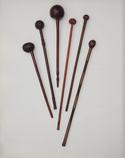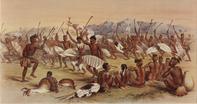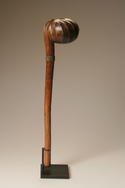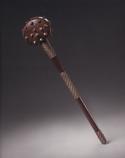
Exceptionally large, heavy knobkerries like the one at the centre of this spread were sometimes used to execute people at the courts of the first Zulu king, Shaka, and his nineteenth-century successors.
To prevent them from cracking later, clubs like these were first prepared by removing the bark from a stump of hardwood, which was then left under the manure in a cattle byre for some time before being carved. Clubs were also fashioned from the roots of trees.

When the artist, George Angas, visited the Zulu kingdom in 1847, one of King Mpande’s generals organised a hunt in his honour. According to Angas a dance was held "previously to starting in search of the buffalo and the various species of antelope" abounding in the surrounding area.
This was followed by a beer-drinking ceremony, after which "the hunting party sallied forth, armed with their knob-kirris, shields, and hunting assegais". Other early observers noted that dancers preparing for a hunt often used sticks to engage in imaginary stabbings of the animals before going out into the bush.
Angas recorded that young boys “had to lie upon the dead game to preserve them from…the influence of witchcraft”, adding that they lay across the animals “as snugly as though they had been reposing on couches of down.”

Bulbous, fluted knobkerries were probably used for defensive purposes or to kill game. The missionary-anthropologist, Junod, who in 1927 published an account of the lives of Tsonga-speaking communities, mentioned the production of knobkerries with fluted heads.
This style appears to have originated around Bilene about 140km north of Maputo in present-day Mozambique. Clubs and knobkerries with fluted heads were also produced by communities living in the neighbouring areas controlled by the Swazi kingdom.

Large-headed, short handled knobkerries were known among Zulu-speakers as an isimonqo. In the eastern Cape colonial officials tried to prevent the use of potentially lethal knobkerries by decreeing that the knob had to be small enough to fit into the mouth of the owner.
This prohibition was circumvented through the addition of brass tacks or studs. Although sticks like these were used mainly for hunting, they could also be employed in person-to-person combat.